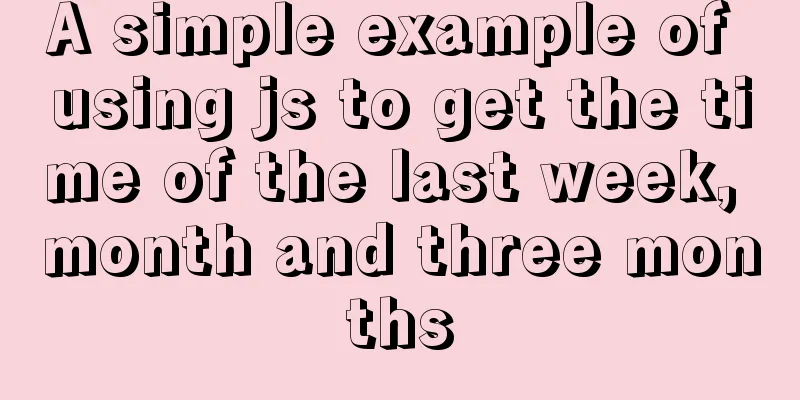A simple example of using js to get the time of the last week, month and three months

Get the time in the past week
var end = new Date();
var year = end.getFullYear();
var month = end.getMonth() + 1; //0-11 means January to December var day = end.getDate();
var dateObj = {};
dateObj.end = year + '-' + month + '-' + day;
if (day - 7 <= 0) { //If it is before the 7th of the month var startMonthDay = new Date(year, (parseInt(month) - 1), 0).getDate(); //Total number of days in the month 1 week ago if (month - 1 <= 0) { //If it is in January of the current year dateObj.start = (year - 1) + '-' + 12 + '-' + (31 - (7 - day));
} else {
dateObj.start = year + '-' + (month - 1) + '-' + (startMonthDay - (7 - day));
}
} else {
dateObj.start = year + '-' + month + '-' + (day - 7);
}
console.log(JSON.stringify(dateObj))
1.2.3.4.5.6.7.8.9.10.11.12.13.14.15.16.17.
Get the time of the past month
var end = new Date();
var year = end.getFullYear();
var month = end.getMonth() + 1; //0-11 means January to December var day = end.getDate();
var dateObj = {};
dateObj.end = year + '-' + month + '-' + day;
var endMonthDay = new Date(year, month, 0).getDate(); //Total number of days in the current month if(month - 1 <= 0){ //If it is January, move forward one year<br>
dateObj.start = (year - 1) + '-' + 12 + '-' + day;
}else{
var startMonthDay = new Date(year, (parseInt(month) - 1), 0).getDate();
if(startMonthDay < day){ //The total number of days in the month one month ago is less than the current date if(day < endMonthDay){ //The current date is less than the total number of days in the current month dateObj.start = year + '-' + (month - 1) + '-' + (startMonthDay - (endMonthDay - day));
}else{
dateObj.start = year + '-' + (month - 1) + '-' + startMonthDay;
}
}else{
dateObj.start = year + '-' + (month - 1) + '-' + day;
}
}
console.log(JSON.stringify(dateObj))
1.2.3.4.5.6.7.8.9.10.11.12.13.14.15.16.17.18.19.20.21.22.
Get the last three months
var end = new Date();
var year = end.getFullYear();
var month = end.getMonth() + 1; //0-11 means January to December var day = end.getDate();
var dateObj = {};
dateObj.end = year + '-' + month + '-' + day;
var endMonthDay = new Date(year, month, 0).getDate(); //Total number of days in the current monthif(month - 3 <= 0){ //If it is January, February or March, move forward one year var start3MonthDay = new Date((year - 1), (12 - (3 - parseInt(month))), 0).getDate(); //Total number of days in the month 3 months ago if(start3MonthDay < day){ //The total number of days in the month 3 months ago is less than the current date dateObj.start = (year - 1) + '-' + (12 - (3 - month)) + '-' + start3MonthDay;
}else{
dateObj.start = (year - 1) + '-' + (12 - (3 - month)) + '-' + day;
}
}else{
var start3MonthDay = new Date(year, (parseInt(month) - 3), 0).getDate(); //Total number of days in the month 3 months ago if(start3MonthDay < day){ //The total number of days in the month 3 months ago is less than the current date if(day < endMonthDay){ //The current date is less than the total number of days in the current month, February is a special month dateObj.start = year + '-' + (month - 3) + '-' + (start3MonthDay - (endMonthDay - day));
}else{
dateObj.start = year + '-' + (month - 3) + '-' + start3MonthDay;
}
}else{
dateObj.start = year + '-' + (month - 3) + '-' + day;
}
}
console.log(JSON.stringify(dateObj))New Date() vs. setDate() ParametersI believe there are already many articles about dates on the Internet. Here I just summarize the problems I encountered at work. new Date() new Date() has six forms, five with parameters and one without parameters;
Parameter Description: month1: In English, it indicates the name of the month; from January to December; dd: indicates date, 1-31 yyyy: indicates the year represented by four digits hh:mm:ss: indicates time, hour (0-23) - minute (0-59) - second (0-59) month2: is a number type month; from 0 to 11; i.e. January to December ms: The number of milliseconds since January 1, 1970 Special reminder: some are in character form and some are not SummarizeThis is the end of this article about how to use js to get the time of the past week, month, and three months. For more related content about how to use js to get the time of a week, month, and three months, please search for previous articles on 123WORDPRESS.COM or continue to browse the related articles below. I hope you will support 123WORDPRESS.COM in the future! You may also be interested in:
|
<<: Implementation of waterfall layout + dynamic rendering
>>: MySQL Database Indexes and Transactions
Recommend
How to install MySQL Community Server 5.6.39
This article records the detailed tutorial of MyS...
Implementation of element shuttle frame performance optimization
Table of contents background Solution New Questio...
Detailed explanation of CocosCreator optimization DrawCall
Table of contents Preface What is DrawCall How do...
How to configure Linux CentOS to run scripts regularly
Many times we want the server to run a script reg...
Best Practices for MySQL Upgrades
MySQL 5.7 adds many new features, such as: Online...
Detailed tutorial on how to automatically install CentOS7.6 using PXE
1. Demand The base has 300 new servers, and needs...
MySQL query duplicate data (delete duplicate data and keep the one with the smallest id as the only data)
Development Background: Recently, I am working on...
CSS multi-column layout solution
1. Fixed width + adaptive Expected effect: fixed ...
MySQL solution for creating horizontal histogram
Preface Histogram is a basic statistical informat...
A brief discussion on HTML special character encoding CSS3 content: "I am a special symbol"
Some special characters and icons used in the pro...
Detailed explanation of key uniqueness of v-for in Vue
Table of contents 1. DOM Diff 2. Add key attribut...
Using JavaScript to implement carousel effects
This article shares the specific code for JavaScr...
Vue+Openlayer batch setting flash point implementation code (based on postrender mechanism)
Effect picture: Implementation code: <template...
Install Docker environment in Linux environment (no pitfalls)
Table of contents Installation Prerequisites Step...
Vue+axios sample code for uploading pictures and recognizing faces
Table of contents Axios Request Qs processing dat...









